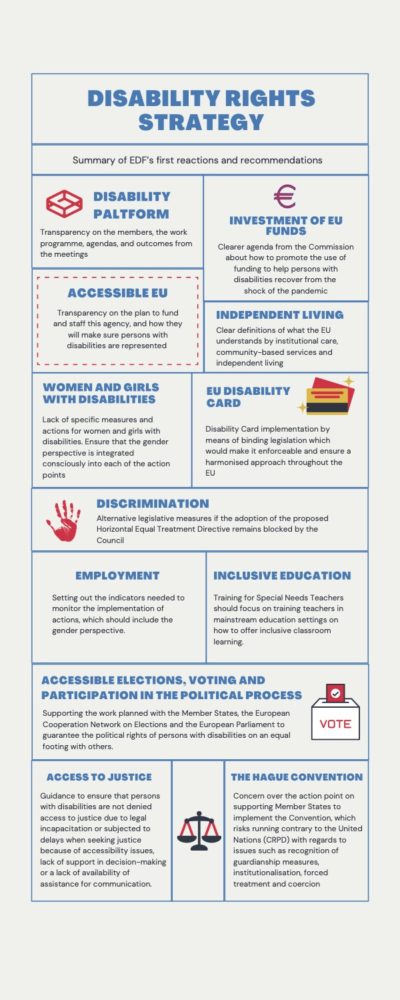The EU Disability Rights Strategy 2021-2030 was launched on the 3rd of March of 2021. Our summary of our first reaction follows on from EDF’s full advocacy position on the new Strategy.
EDF is pleased to see that the EU Disability Rights Strategy 2021-2030 is a clear step forward in comparison to the previous Strategy. It is also to be highly commended that the European Commission (EC) took the process of consultation with disability organisations very seriously. It is positive to see that the seven flagship proposals within the Strategy are clear in their objective. Furthermore, we welcome the fact that the Commission commits to dates by which these key actions must be delivered. This level of transparency will greatly facilitate the work of civil society and social partners, in preparing their input for these actions.
We believe that the EU Disability Rights Strategy has the potential to achieve real, significant and tangible change, but that this depends entirely on how well it is implemented and how ambitious the individual actions are when they are executed. If the European Commission and the Member States are not ambitious in pushing for actions that challenge the status quo and vastly improve how any persons with disabilities currently live, the Strategy faces a real risk of falling short of the expectations of the more than 100 million persons with disabilities in the EU.
This summary offers a condensed overview of our response to it and analysis of it. Download and read the complete summary of our first reaction.

[ALT TEXT: Disability Rights Strategy Infographic. Summary of EDF’s first reactions and recommendations. It can be seen 12 main areas:
- Disability Platform: Transparency on the members, the work programme, agendas, and outcomes from the meetings
- Investment of EU Funds: Clearer agenda from the Commission about how to promote the use of funding to help persons with disabilities recover from the shock of the pandemic
- Accessible EU: Transparency on the plan to fund and staff this agency, and how they will make sure persons with disabilities are represented
- Independent Living: Clear definitions of what the EU understands by institutional care, community-based services and independent living.
- Women and girls with Disabilities: Lack of specific measures and actions for women and girls with disabilities. Ensure that the gender perspective is integrated consciously into each of the action points.
- EU Disability Card: Disability Card implementation by means of binding legislation which would make it enforceable and ensure a harmonised approach throughout the EDF.
- Discrimination: Alternative legislative measures if the adoption of the proposed Horizontal Equal Treatment Directive remains blocked by the Council.
- Employment: Setting out the indicators needed to monitor the implementation of actions, which should include the gender perspective.
- Inclusive Education: Training for Special Needs Teachers should focus on training teachers in mainstream education settings on how to offer inclusive classroom learning.
- Accessible Elections, Voting and Participation in the Political Process: Supporting the work planned with the Member States, the European Cooperation Network on Elections and the European Parliament to guarantee the political rights of persons with disabilities on an equal footing with others.
- Access to Justice: Guidance to ensure that persons with disabilities are not denied access to justice due to legal incapacitation or subjected to delays when seeking justice because of accessibility issues, lack of support in decision-making or a lack of availability of assistance for communication.
- The Hague Convention: Concern over the action point on supporting Member States to implement the Convention, which risks running contrary to the United Nations (CRPD) with regards to issues such as recognition of guardianship measures, institutionalisation, forced treatment and coercion.]
Download the infografic of our first reaction.
More information on the #EUDisability Rights Strategy